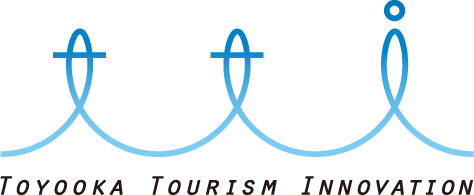【Press Release】7 Hot Spring Bathhouses Reunited At Last
Some tourists to Kinosaki Onsen make a point of visiting all 7 public hot springs (onsen) during their stay. However, this has not been possible this past year as one of them, Goshono-yu, had unfortunately been closed for renovations. We are delighted to announce that a ceremony marking its re-opening was held on November 2nd, 2020!
- Goshono-yu’s new outdoor-only bath, built in the likeness of Kyoto’s Imperial Palace
Goshono-yu was built in the likeness of Kyoto’s Imperial Palace. This is because, the sister of Emperor Gohorikawa is said to have come here to bathe in the 1200s. The foyer and lounge area are furnished with beautiful screens, and the panels of the high ceiling are painted with Japanese flowers. Visitors to the bathhouse are greeted by a gorgeous lotus pond at the entrance. Goshono-yu saw about 400,000 such visitors per year, until August 2019 when it closed to repair its wooden canopy. Although it is traditional for an onsen to have an indoor and outdoor portion, Goshono-yu is now unique among the 7 onsen to be the only one that is a full-scale open-air bath. For those who would like to be fully enveloped by the healing properties of the water, there are also areas in which one can lie down or stand.
The natural landscape is said to mimic the mountains of Tajima, a region in northern Hyogo Prefecture to which Kinosaki Onsen belongs. The famous waterfall in the back of the bath has been left as is, and one can enjoy the changing colors of the surrounding autumn leaves from mid-November. Guests can soak in the outdoor bath surrounded by lush trees, bathe in natural light, and relax to the crashing sounds of the waterfall in the background.
To commemorate Goshono-yu’s re-opening, there was a special event in collaboration with the married picture book creative unit Tupera Tupera, who published a picture book called Panda Sento or Panda Bath. At the event, the picture book came to life through various panda decorations at Goshono-yu, a scavenger hunt with prizes, and fictional products such as “bamboo grass cider” (really just melon soda) available at the front desk. This event, named Panda-yu, was a big hit with the local community to celebrate the return of the popular bathhouse.
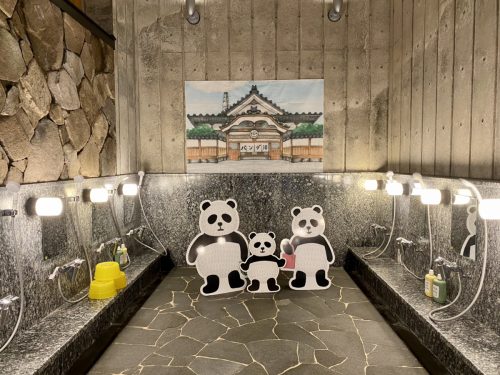
Panda-yu event in Goshono-yu’s shower area
Goshono-yu is just one of 7 public bathhouses (onsen) in Kinosaki, each one having its own distinct charms and features. Guests who stay in a traditional Japanese inn (ryokan) receive a pass to all 7 bathhouses, which are located within walking distance of one another. Thus, during their stay, these guests can visit as many bathhouses as they want. Visitors can enjoy strolling through town, taking pictures alongside the willow-lined canal, and basking in the area’s peaceful atmosphere while onsen-hopping. In between trips to the bathhouses, visitors can shop for souvenirs, stop for dessert, and play retro Japanese arcade games. Those staying in an inn will also receive a yukata, a light cotton robe similar to a kimono, to wear while they make their way around town.
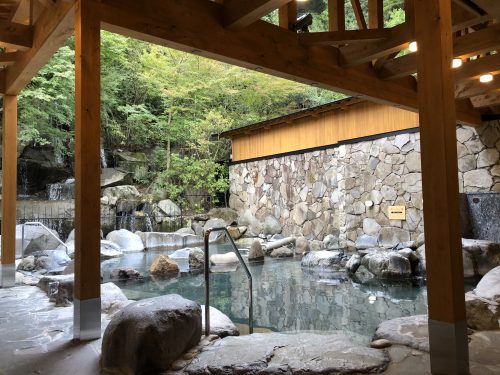
Goshono-yu, which re-opened on November 2nd, 2020
To help find their way to each bathhouse, guests can purchase a pamphlet with a map and a stamp collection section on the back. One will find a special stamp for said pamphlet at each bathhouse. This pamphlet can be received or purchased at various accommodations in town, depending on the inn. Some inns also offer the chance to get a commemorative gift for completing this hot spring pilgrimage. Additionally, the first male and female guests of the day to any of the 7 bathhouses will receive a custom wooden plaque with the name of the bathhouse and the date of entry. No matter how many bathhouses one chooses to visit during their time in Kinosaki Onsen, visitors are guaranteed to have a good time discovering what truly defines a traditional onsen town experience.
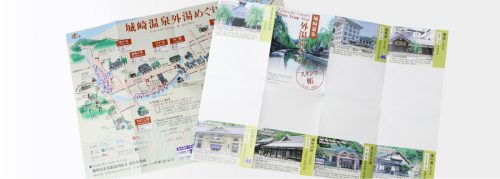
Onsen stamp rally pamphlet
-500x333.jpg)
Wooden plaques for the first entrants of each bathhouse

w-500x384.jpg)
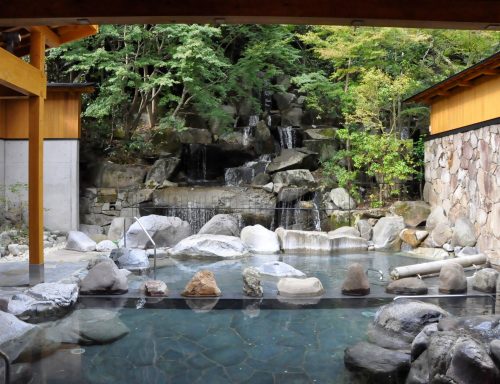
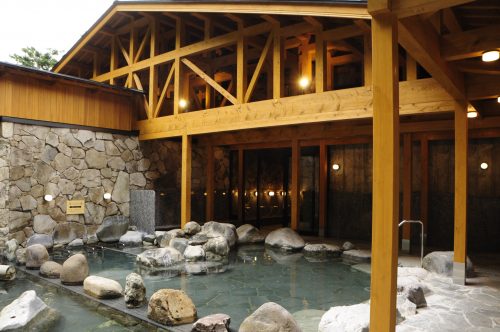
w-500x347.jpg)
